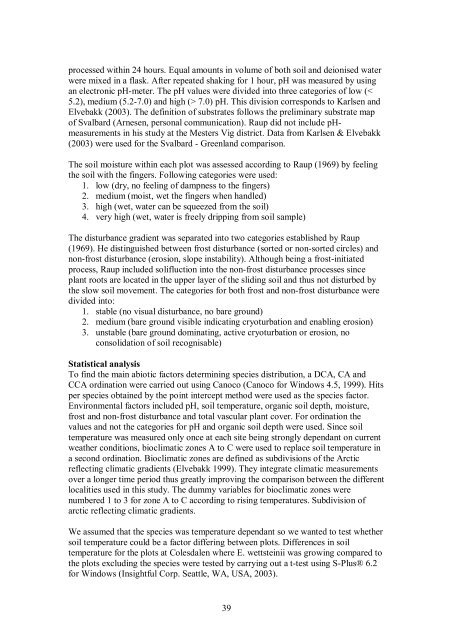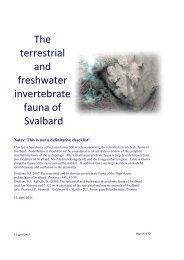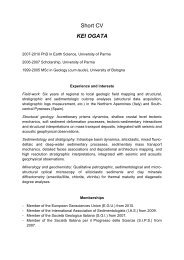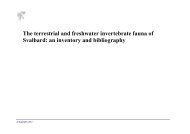Arctic plant ecology: From tundra to polar desert in Svalbard - Unis
Arctic plant ecology: From tundra to polar desert in Svalbard - Unis
Arctic plant ecology: From tundra to polar desert in Svalbard - Unis
You also want an ePaper? Increase the reach of your titles
YUMPU automatically turns print PDFs into web optimized ePapers that Google loves.
processed with<strong>in</strong> 24 hours. Equal amounts <strong>in</strong> volume of both soil and deionised water<br />
were mixed <strong>in</strong> a flask. After repeated shak<strong>in</strong>g for 1 hour, pH was measured by us<strong>in</strong>g<br />
an electronic pHmeter. The pH values were divided <strong>in</strong><strong>to</strong> three categories of low (<<br />
5.2), medium (5.27.0) and high (> 7.0) pH. This division corresponds <strong>to</strong> Karlsen and<br />
Elvebakk (2003). The def<strong>in</strong>ition of substrates follows the prelim<strong>in</strong>ary substrate map<br />
of <strong>Svalbard</strong> (Arnesen, personal communication). Raup did not <strong>in</strong>clude pH<br />
measurements <strong>in</strong> his study at the Mesters Vig district. Data from Karlsen & Elvebakk<br />
(2003) were used for the <strong>Svalbard</strong> Greenland comparison.<br />
The soil moisture with<strong>in</strong> each plot was assessed accord<strong>in</strong>g <strong>to</strong> Raup (1969) by feel<strong>in</strong>g<br />
the soil with the f<strong>in</strong>gers. Follow<strong>in</strong>g categories were used:<br />
1. low (dry, no feel<strong>in</strong>g of dampness <strong>to</strong> the f<strong>in</strong>gers)<br />
2. medium (moist, wet the f<strong>in</strong>gers when handled)<br />
3. high (wet, water can be squeezed from the soil)<br />
4. very high (wet, water is freely dripp<strong>in</strong>g from soil sample)<br />
The disturbance gradient was separated <strong>in</strong><strong>to</strong> two categories established by Raup<br />
(1969). He dist<strong>in</strong>guished between frost disturbance (sorted or nonsorted circles) and<br />
nonfrost disturbance (erosion, slope <strong>in</strong>stability). Although be<strong>in</strong>g a frost<strong>in</strong>itiated<br />
process, Raup <strong>in</strong>cluded solifluction <strong>in</strong><strong>to</strong> the nonfrost disturbance processes s<strong>in</strong>ce<br />
<strong>plant</strong> roots are located <strong>in</strong> the upper layer of the slid<strong>in</strong>g soil and thus not disturbed by<br />
the slow soil movement. The categories for both frost and nonfrost disturbance were<br />
divided <strong>in</strong><strong>to</strong>:<br />
1. stable (no visual disturbance, no bare ground)<br />
2. medium (bare ground visible <strong>in</strong>dicat<strong>in</strong>g cryoturbation and enabl<strong>in</strong>g erosion)<br />
3. unstable (bare ground dom<strong>in</strong>at<strong>in</strong>g, active cryoturbation or erosion, no<br />
consolidation of soil recognisable)<br />
Statistical analysis<br />
To f<strong>in</strong>d the ma<strong>in</strong> abiotic fac<strong>to</strong>rs determ<strong>in</strong><strong>in</strong>g species distribution, a DCA, CA and<br />
CCA ord<strong>in</strong>ation were carried out us<strong>in</strong>g Canoco (Canoco for W<strong>in</strong>dows 4.5, 1999). Hits<br />
per species obta<strong>in</strong>ed by the po<strong>in</strong>t <strong>in</strong>tercept method were used as the species fac<strong>to</strong>r.<br />
Environmental fac<strong>to</strong>rs <strong>in</strong>cluded pH, soil temperature, organic soil depth, moisture,<br />
frost and nonfrost disturbance and <strong>to</strong>tal vascular <strong>plant</strong> cover. For ord<strong>in</strong>ation the<br />
values and not the categories for pH and organic soil depth were used. S<strong>in</strong>ce soil<br />
temperature was measured only once at each site be<strong>in</strong>g strongly dependant on current<br />
weather conditions, bioclimatic zones A <strong>to</strong> C were used <strong>to</strong> replace soil temperature <strong>in</strong><br />
a second ord<strong>in</strong>ation. Bioclimatic zones are def<strong>in</strong>ed as subdivisions of the <strong>Arctic</strong><br />
reflect<strong>in</strong>g climatic gradients (Elvebakk 1999). They <strong>in</strong>tegrate climatic measurements<br />
over a longer time period thus greatly improv<strong>in</strong>g the comparison between the different<br />
localities used <strong>in</strong> this study. The dummy variables for bioclimatic zones were<br />
numbered 1 <strong>to</strong> 3 for zone A <strong>to</strong> C accord<strong>in</strong>g <strong>to</strong> ris<strong>in</strong>g temperatures. Subdivision of<br />
arctic reflect<strong>in</strong>g climatic gradients.<br />
We assumed that the species was temperature dependant so we wanted <strong>to</strong> test whether<br />
soil temperature could be a fac<strong>to</strong>r differ<strong>in</strong>g between plots. Differences <strong>in</strong> soil<br />
temperature for the plots at Colesdalen where E. wettste<strong>in</strong>ii was grow<strong>in</strong>g compared <strong>to</strong><br />
the plots exclud<strong>in</strong>g the species were tested by carry<strong>in</strong>g out a ttest us<strong>in</strong>g SPlus® 6.2<br />
for W<strong>in</strong>dows (Insightful Corp. Seattle, WA, USA, 2003).<br />
39








